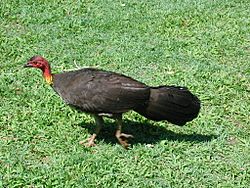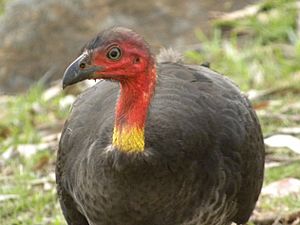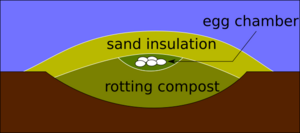Megapode facts for kids
Quick facts for kids Megapodiidae |
|
|---|---|
 |
|
| Alectura lathami | |
| Scientific classification | |
| Kingdom: | |
| Phylum: | |
| Class: | |
| Order: | |
| Family: |
Megapodiidae
Lesson, 1831
|
| Genera | |
|
|
The megapodes, also known as incubator birds or mound-builders, are stocky, medium-sized birds. They look a bit like chickens but have small heads and very large feet. These birds belong to the family called Megapodiidae. They are famous for building big piles of rotting plants to keep their eggs warm, acting like a natural incubator.
Contents
What are Megapodes?
Megapodes are medium to large birds that live on the ground. They have strong legs and feet with sharp claws. The biggest megapodes are the Alectura and Talegalla species. The smallest ones are the Micronesian scrubfowl and the Moluccan scrubfowl.
These birds have small heads, short beaks, and large, rounded wings. How well they fly can be different for each type of megapode. Unlike most other chicken-like birds, megapodes have their back toe (called a hallux) at the same level as their front toes.
Where Megapodes Live
Megapodes are found in the wider Australasian region. This includes islands in the western Pacific, Australia, New Guinea, and islands in Indonesia that are east of the Wallace Line. They also live on the Andaman and Nicobar Islands in the Bay of Bengal.
Sadly, the areas where megapodes live have shrunk in the Pacific. This happened after humans arrived. Many island groups, like Fiji, Tonga, and New Caledonia, have lost some or all of their megapode species.
Reproduction and Life Cycle
Megapodes are mostly solitary birds, meaning they live alone. They are very unusual because they do not sit on their eggs to keep them warm, like most other birds do. Instead, they bury their eggs. Their eggs are also special because they have a very large yolk, which makes up 50–70% of the egg's weight.
Building and Managing Nests
These birds are best known for building huge nest mounds. These mounds are made of decaying plants and soil. The male bird usually takes care of the mound. He adds or removes material to control the heat inside, making sure the eggs stay at the right temperature as they grow.
However, some megapodes bury their eggs in other ways. Some dig burrows and use heat from the Earth (geothermal heat). Others simply rely on the sun warming the sand to incubate their eggs. Some species might even change their nesting strategy depending on what the local environment is like.
Hatching and Growing Up
Megapode chicks are born without an egg tooth, which most birds use to break out of their shell. Instead, they use their strong claws to crack open the egg. Then, they tunnel their way up to the surface of the mound. They lie on their backs and scratch at the sand and plant matter to get out.
These chicks are super-precocial. This means they hatch fully feathered and are very active right away. They can even fly and live on their own almost immediately after hatching! They don't need their parents to feed or protect them.
Scientists wondered how these chicks, who don't spend time with their parents, learn to recognize other megapodes. Research suggests they have an instinct to recognize specific ways other megapodes move.
Species of Megapodes
There are more than 20 living species of megapodes. They are grouped into seven different genera (types). Even though it's hard to know the exact family tree of all megapodes, the main groups of how they look are clear.
See also
 In Spanish: Talégalos para niños
In Spanish: Talégalos para niños




